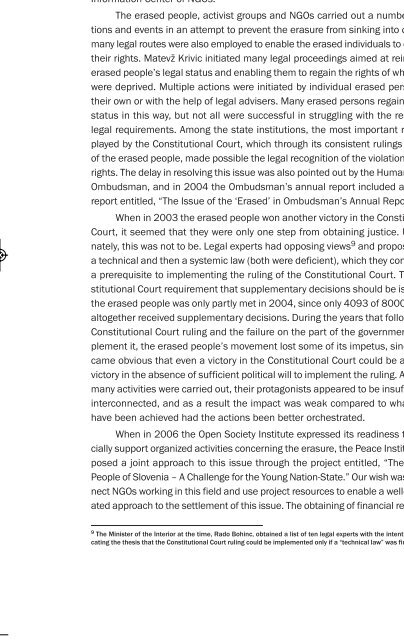The Scars of the Erasure_web
The Scars of the Erasure_web
The Scars of the Erasure_web
- No tags were found...
You also want an ePaper? Increase the reach of your titles
YUMPU automatically turns print PDFs into web optimized ePapers that Google loves.
<strong>Erasure</strong>_4a 10.1.11 20:29 Page 1212 THE SCARS OF THE ERASUREKrivic, <strong>the</strong> Civil Initiative <strong>of</strong> <strong>the</strong> Erased Activists (CIIA) and its chairman, AleksandarTodorović, <strong>the</strong>ir many supporters from academia and civil society, and lastbut not least, <strong>the</strong> NGOs working in <strong>the</strong> field <strong>of</strong> human rights, such as AmnestyInternational Slovenia, <strong>the</strong> Helsinki Monitor, <strong>the</strong> Peace Institute, and PIC – LegalInformation Center <strong>of</strong> NGOs.<strong>The</strong> erased people, activist groups and NGOs carried out a number <strong>of</strong> actionsand events in an attempt to prevent <strong>the</strong> erasure from sinking into oblivion;many legal routes were also employed to enable <strong>the</strong> erased individuals to exercise<strong>the</strong>ir rights. Matevž Krivic initiated many legal proceedings aimed at reinstatingerased people’s legal status and enabling <strong>the</strong>m to regain <strong>the</strong> rights <strong>of</strong> which <strong>the</strong>ywere deprived. Multiple actions were initiated by individual erased persons on<strong>the</strong>ir own or with <strong>the</strong> help <strong>of</strong> legal advisers. Many erased persons regained <strong>the</strong>irstatus in this way, but not all were successful in struggling with <strong>the</strong> restrictivelegal requirements. Among <strong>the</strong> state institutions, <strong>the</strong> most important role wasplayed by <strong>the</strong> Constitutional Court, which through its consistent rulings in favor<strong>of</strong> <strong>the</strong> erased people, made possible <strong>the</strong> legal recognition <strong>of</strong> <strong>the</strong> violation <strong>of</strong> <strong>the</strong>irrights. <strong>The</strong> delay in resolving this issue was also pointed out by <strong>the</strong> Human RightsOmbudsman, and in 2004 <strong>the</strong> Ombudsman’s annual report included a specialreport entitled, “<strong>The</strong> Issue <strong>of</strong> <strong>the</strong> ‘Erased’ in Ombudsman’s Annual Reports.”When in 2003 <strong>the</strong> erased people won ano<strong>the</strong>r victory in <strong>the</strong> ConstitutionalCourt, it seemed that <strong>the</strong>y were only one step from obtaining justice. Unfortunately,this was not to be. Legal experts had opposing views 9 and proposed firsta technical and <strong>the</strong>n a systemic law (both were deficient), which <strong>the</strong>y considereda prerequisite to implementing <strong>the</strong> ruling <strong>of</strong> <strong>the</strong> Constitutional Court. <strong>The</strong> ConstitutionalCourt requirement that supplementary decisions should be issued to<strong>the</strong> erased people was only partly met in 2004, since only 4093 <strong>of</strong> 8000 peoplealtoge<strong>the</strong>r received supplementary decisions. During <strong>the</strong> years that followed <strong>the</strong>Constitutional Court ruling and <strong>the</strong> failure on <strong>the</strong> part <strong>of</strong> <strong>the</strong> government to implementit, <strong>the</strong> erased people’s movement lost some <strong>of</strong> its impetus, since it becameobvious that even a victory in <strong>the</strong> Constitutional Court could be a Pyrrhicvictory in <strong>the</strong> absence <strong>of</strong> sufficient political will to implement <strong>the</strong> ruling. Althoughmany activities were carried out, <strong>the</strong>ir protagonists appeared to be insufficientlyinterconnected, and as a result <strong>the</strong> impact was weak compared to what couldhave been achieved had <strong>the</strong> actions been better orchestrated.When in 2006 <strong>the</strong> Open Society Institute expressed its readiness to financiallysupport organized activities concerning <strong>the</strong> erasure, <strong>the</strong> Peace Institute proposeda joint approach to this issue through <strong>the</strong> project entitled, “<strong>The</strong> ErasedPeople <strong>of</strong> Slovenia – A Challenge for <strong>the</strong> Young Nation-State.” Our wish was to connectNGOs working in this field and use project resources to enable a well-deliberatedapproach to <strong>the</strong> settlement <strong>of</strong> this issue. <strong>The</strong> obtaining <strong>of</strong> financial resources9 <strong>The</strong> Minister <strong>of</strong> <strong>the</strong> Interior at <strong>the</strong> time, Rado Bohinc, obtained a list <strong>of</strong> ten legal experts with <strong>the</strong> intention <strong>of</strong> vindicating<strong>the</strong> <strong>the</strong>sis that <strong>the</strong> Constitutional Court ruling could be implemented only if a “technical law” was first adopted.


